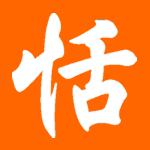I saw this "Wall Hanging Asian Character" for sale at a local Bed Bath and Beyond store. The character 著 has an English caption stating it means "tranquility". The truth is far from "tranquil".
Depends on how 著 is used as in a phrase or sentence, it has many meanings including "catch; receive; suffer", "to make known; to show; to prove; to write; book; outstanding", and "plan; settlement; to wear", but none of them means "tranquility".


In Japanese, this kanji is often used as an abbreviation for "written by" on books, the same way 訳 is used to abbreviate "translated by". It frequently appears on book covers in Japan.
ReplyDeleteFor example, a book written by Hiroshi might say ヒロシ著
The above is identical to a common use of this character in Chinese. Others are, as a verb, "to write [larger literary works]," "outstanding"; and as a noun is used in words like "celebrated; famous" 著名, and by extension from verb to noun as "book." Placed after a verb, it's pronounced neutral "zhe" and is a grammatical particle with several functions; the most common I know of is showing that the verb is in a continuing state. It seems that 着 is now used for 著 as a particle (at least on the mainland). And they're reversed in other places as well: e.g., 着急 in the mainland but 著急 in Taiwan. Anyone know why, exactly?
ReplyDeleteI notice that 著 lists the compound 沈著 with the translation "calm and steady; slow but sure". That sounds at least somewhat synonymous with "tranquil".
ReplyDelete沈 means "sink" or "steady", that is why when it combines with 著, they form a new phrase meaning "calm" or "tranquil".
ReplyDeleteThat is only when the phrase appears with both characters. Just by 著 itself, it does not bear the meaning of "tranquil" at all.
The biggest misnomer Westerners have with Chinese is that each English word can be represented by one single Chinese character. This may be true for some cases, but not all the time.
To represent something complex, multiple characters are used to form a phrase, and with the additional secondary characters, the combine meaning is then presented.
There may be some crossover between the little words 者 ("the one who ...") and 着 (marking continuing action), but 著 is not a correct way to write either one.
ReplyDeleteMaybe they meant 箸, "chopsticks." It wouldn't translate to "tranquility," but they might have seen it on a package.
Anon, "correct" or not, 著 is used for 着 by millions of people, and taught as correct to millions of native Chinese by native Chinese. Check the Far East dictionary or anything else published in Taiwan. Mainland dictionaries of modern standard Chinese include it as an 异体字. Neither 者 nor 箸 have anything to do with either 著 or 着.
ReplyDelete著 is a confusing character because it comes in at least 5 different pronunciations in Chinese:
ReplyDeletezhao1: a chess move
zhao2: touch, feel, sleep
zhuo2: to wear (clothing)
zhu4: outstanding, remarkable
zhe0: progressive particle (like English -ing)
As far as I know, the fifth example above is written 着 in mainland China but it's invariably written 著 in Taiwan.
I appreciate Allen's correction, and I take back my foolish claim about 著 not being a "correct" form of 着. I belatedly pulled some dictionaries off the shelf and took a look. It's clearly known in that usage in both Mainland China and Taiwan.
ReplyDeleteIt even (traditionally) means "bloom," when used with "flower." Look at this Wang Wei jueju (quatrain) from the Tang:
ReplyDelete君自故鄉來,應知故鄉事,來日綺窗前,寒梅著花未.
Wang Li (who if you know you can bet is right) glosses 著花 as 開花, and gives "zhuo" in 2nd tone as the pronunciation. If you have Vol.1 of his 古代漢語, p.229 explains that originally the character is "zhu4," meaning (1)顯露 (become visible; appear; manifest itself; flowering),(2)寫下來 (write down)--and here he adds "這個意義又寫作箸"; before now I'd only known 箸 as Japanese "hashi"; Looks like you had something there after all, anon! Keep in mind the above are ancient. (3) (still premodern times), read zhuo2 (entering tone back then), and "附着" (dependent on 着), also written 着, and split into lots of meanings. (4) again read zhuo2 (entering tone); wear (clothes). Then he notes a bunch of interesting stuff, that 着 is now generally used, and 著 is now officially only "zhu4," and the two have split apart (pronunciations and meanings), which of course doesn't apply to things like the above poem, where it should be approximated as zhuo2 (rusheng). and so on. Isn't this fun?
I'd better plead guilty to the above email with the poem--too many anons here
ReplyDelete--Allen
Someone could probably write a thesis on this. 詩詞曲語辭匯釋 by 張相 (2 vols., 1991 repr. of Beijing:Zhonghua, 1953) pp.293-317, has 22 meanings for 着; actually 22 detailed studies over 24 pages is what he has (that would maybe 60 or 80 pages if translated into English). Any volunteers? Not busy the next few days?
ReplyDeleteToo many anons indeed, and so far I've been too lazy to register. I was the one who made the foolish claim earlier. I do not have Wang Li, but I thought I knew the Wang Wei poem, and I didn't know how to pronounce 著花 properly. So this is a good place to learn stuff. John
ReplyDeleteIf anyone is interested, tranquility can be written 宁静 ning jing... a far cry from 著
ReplyDeleteOK. I saw the same or a simlar symbol in the store. I believe it was a little different and had a very nice statement of what was meant by Tranquility.
ReplyDeleteCan someone tell me where I can find the "true" Tranquility drawing? After reading the explaination of tranquility I am seriously considering it to be my first tatoo